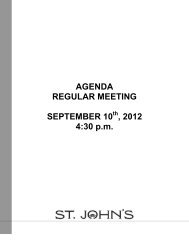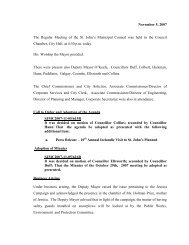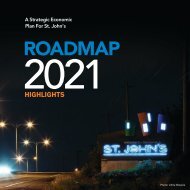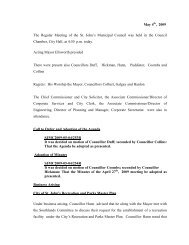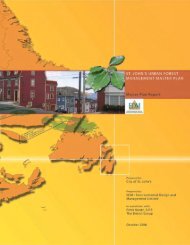St. John's Municipal Plan Review 2012 ... - City of St. John's
St. John's Municipal Plan Review 2012 ... - City of St. John's
St. John's Municipal Plan Review 2012 ... - City of St. John's
- No tags were found...
You also want an ePaper? Increase the reach of your titles
YUMPU automatically turns print PDFs into web optimized ePapers that Google loves.
<strong>St</strong>. John’s <strong>Municipal</strong> <strong>Plan</strong> <strong>Review</strong> <strong>2012</strong>BACKGROUND REPORTFebruary 15, <strong>2012</strong>
i<strong>St</strong>. John’s <strong>Municipal</strong> <strong>Plan</strong> <strong>Review</strong> <strong>2012</strong>: Background ReportMessage from the Chair...This report is the first step in the review <strong>of</strong> the <strong>St</strong>. John’s <strong>Municipal</strong> <strong>Plan</strong>, 2003. The resultwill be a new <strong>Municipal</strong> <strong>Plan</strong> that will help shape our city for the next 10 years or more.Our current <strong>Plan</strong>, which was approved by <strong>St</strong>. John’s <strong>Municipal</strong> Council in 2003, will bereviewed in light <strong>of</strong> today’s conditions. Our city has grown and our population is increasing.We need to look at where we should grow and how to create and maintain safe, pleasantneighbourhoods with shops, parks and services nearby, while fostering a productive businessclimate. The <strong>Municipal</strong> <strong>Plan</strong> will set out ways to reuse old buildings and develop newbuildings in established neighbourhoods. We must look at how to make the best use <strong>of</strong> ourheritage area and heritage buildings. Our review will also look at protecting land aroundlakes, rivers, and coastlines; how we can support farming and other rural land uses; andreserving land for present and future drinking-water supplies. The <strong>Municipal</strong> <strong>Plan</strong> also looksat how the layout <strong>of</strong> the city can help traffic move, while supporting walking, public transit,and cycling. There is much more to consider and there will be ample opportunities for publicinput into the process.Overall, the <strong>Municipal</strong> <strong>Plan</strong> expresses Council’s policies on land-use and development,based on the needs and desires <strong>of</strong> the city as a whole.Councillor Tom HannChair <strong>of</strong> the <strong>Plan</strong>ning and Housing <strong>St</strong>anding Committee
3 <strong>St</strong>. John’s <strong>Municipal</strong> <strong>Plan</strong> <strong>Review</strong> <strong>2012</strong>: Background ReportIntroductionLand-use planning affects many aspects <strong>of</strong>life in <strong>St</strong>. John’s. It helps determine wherewe live and where we go to work; whereparks and recreational facilities should be;where our schools and hospitals are built;and where roads, sewers and other essentialservices are needed.Land-use planning helps manage our landand resources responsibly. It helps <strong>St</strong>.John’s set goals about how we will growand develop while keeping importantsocial, economic and environmentalconcerns in mind. It balances the interests<strong>of</strong> individual property owners with theobjectives <strong>of</strong> the entire community. Goodplanning leads to orderly growth and theefficient provision <strong>of</strong> services. It helps usto have the kind <strong>of</strong> community we want.A municipal plan is a legal documentwhich sets out the municipality’s vision,goals, objectives and policies for thelong-term development <strong>of</strong> land and theprovision <strong>of</strong> services and amenities.The municipal plan expresses thevalues <strong>of</strong> the community, responding tochanging circumstances over time. Allmunicipalities in Newfoundland andLabrador are required under the Province’sUrban and Rural <strong>Plan</strong>ning Act to have amunicipal plan.The <strong>City</strong> <strong>of</strong> <strong>St</strong>. John’s is now startinga review <strong>of</strong> our <strong>St</strong>. John’s <strong>Municipal</strong><strong>Plan</strong>, 2003, and the associated <strong>St</strong>. John’sLand-Use Zoning and SubdivisionRegulations (commonly called the <strong>St</strong>.John’s Development Regulations). ThisBackground Report has been prepared as asource document to be used by Council andthe general public as a basis for dialogueand informed decision-making.This report will summarize existingconditions in the <strong>City</strong> <strong>of</strong> <strong>St</strong>. John’s andthe <strong>St</strong>. John’s Census Metropolitan Area(CMA) in a number <strong>of</strong> subject areas. Some<strong>of</strong> the issues which have emerged since the2003 <strong>Municipal</strong> <strong>Plan</strong> was adopted will bediscussed as well.
6 <strong>St</strong>. John’s <strong>Municipal</strong> <strong>Plan</strong> <strong>Review</strong> <strong>2012</strong>: Background ReportBackground<strong>St</strong>. John’s <strong>Municipal</strong> <strong>Plan</strong>, 2003The present <strong>St</strong>. John’s <strong>Municipal</strong> <strong>Plan</strong>was adopted by Council on June 9, 2003,and came into legal effect on December 5,2003. The <strong>City</strong> <strong>of</strong> <strong>St</strong>. John’s adopted its firstmunicipal plan under the Urban and Rural<strong>Plan</strong>ning Act in 1984. Land-use regulationsgo back to the <strong>St</strong>. John’s Zoning By-Law,1955, which was adopted by Council underthe <strong>City</strong> <strong>of</strong> <strong>St</strong>. John’s Act.The Watershed District is the single largestland-use district, making up 27 per cent<strong>of</strong> all the land in <strong>St</strong>. John’s. This reflectsthe presence <strong>of</strong> five separate watersheds toprotect drinking water. The watersheds, andother Resource and Environmental lands (inthe Agricultural, Restricted Development,and Forestry districts) occupy slightly morethan half the total area <strong>of</strong> <strong>St</strong>. John’s.The 2003 <strong>St</strong>. John’s <strong>Municipal</strong> <strong>Plan</strong> isdivided into four parts:• Part I: Purpose and Scope: Thisprovides background information onrevisions to the previous <strong>Municipal</strong><strong>Plan</strong> and describes the legal basis forthe plan.• Part II: Vision: This general statementsets out the framework for the<strong>Municipal</strong> <strong>Plan</strong>.• Part III: <strong>City</strong>-Wide Objectives andPolicies: These apply to the entire city,or to portions <strong>of</strong> it in particular land-usedistricts.• Part IV: <strong>Plan</strong>ning-Area Development<strong>Plan</strong>s: The <strong>City</strong> is divided into 21planning areas; some <strong>of</strong> these haveDevelopment <strong>Plan</strong>s which have moredetail than the <strong>Municipal</strong> <strong>Plan</strong>. Forexample, the Goulds (<strong>Plan</strong>ning Area 16)has a <strong>Plan</strong>ning-Area Development <strong>Plan</strong>.They were originally called planningareadevelopment schemes.Rural lands, which are not intended to beprovided with municipal water and sewerservices, occupy a fifth <strong>of</strong> the city. Ofthe remaining land area, eight per cent isdesignated as Residential and eight per centis for Parks and Recreation. Employmentlands – those designated Commercial orIndustrial – make up only 5.2 per cent <strong>of</strong> thecity’s land area.On January 1, 1992, the land area <strong>of</strong> the <strong>City</strong><strong>of</strong> <strong>St</strong>. John’s increased dramatically, from101 to 483 square kilometres. On that date,the Provincial Government amalgamatedthe <strong>City</strong> with the former towns <strong>of</strong> Gouldsand Wedgewood Park, the unincorporatedcommunity <strong>of</strong> Blackhead, the lands onIncinerator Road outside Foxtrap in theTown <strong>of</strong> Conception Bay South, andrural areas that were administered by theformer <strong>St</strong>. John’s Metropolitan Area Board,including Southlands. On the same date,Metro Board was disbanded.
7 <strong>St</strong>. John’s <strong>Municipal</strong> <strong>Plan</strong> <strong>Review</strong> <strong>2012</strong>: Background ReportBackground<strong>Municipal</strong> <strong>Plan</strong> AmendmentsThe Urban and Rural <strong>Plan</strong>ning Act makesprovision for a municipality to amend itsmunicipal plan and development regulations.This reflects the fact that conditions canchange, or developments can be proposedthat make good sense but were not foreseenwhen the plan was written. Any municipalplan is a living document.Text amendments to the current <strong>St</strong>.John’s <strong>Municipal</strong> <strong>Plan</strong> and DevelopmentRegulations include: the creation <strong>of</strong> anecclesiastical district (centered on the maindowntown churches, schools, and religiousbuildings within the Heritage District;the introduction <strong>of</strong> design guidelines forthe Battery neighbourhood and the lowerparts <strong>of</strong> Signal Hill; the allowance <strong>of</strong> fullyresidential buildings in Commercial districts;allowing greater building bulk and height inparts <strong>of</strong> the Commercial Downtown District;changes to allow different types <strong>of</strong> farmingto help farmers adapt their operations; anda change to allow multiple dwellings (withno more than six units) as a discretionaryuse in the Residential Medium Density (R2)Zone as a way <strong>of</strong> encouraging residentialintensification.
9 <strong>St</strong>. John’s <strong>Municipal</strong> <strong>Plan</strong> <strong>Review</strong> <strong>2012</strong>: Background Report<strong>Plan</strong>ning Issues in <strong>St</strong>. John’sHousingThe <strong>City</strong>’s Department <strong>of</strong> Building andProperty Management shows that anaverage <strong>of</strong> 550 single detached houses arebeing built in <strong>St</strong>. John’s annually. Between2000 and 2011, there were 6,042 singlehouses built; <strong>of</strong> these, 17 per cent (or 1,036houses) contained subsidiary or basementapartments.average (79 per cent).The price <strong>of</strong> new housing has been steadilygoing up, increasing by 19.6 per cent in2008, 11.5 per cent in 2009, and 15.5 percent in 2010, which caused the average price<strong>of</strong> a new single-detached house in the <strong>St</strong>.John’s CMA to reach $325,436.In 2006, there were 41,540 dwellingunits (this includes single houses, semidetachedor double houses, row houses, andapartments) in the <strong>City</strong>.The dominant housing form is the singledetached house which constituted 42.5 percent <strong>of</strong> the total housing stock. Units inapartment buildings were the least common,constituting 14.2 per cent <strong>of</strong> the stock.Almost one-half <strong>of</strong> all units were constructedbefore 1971, and a third <strong>of</strong> those (5,700houses) were built before 1946.Between 2002 and 2010, the average cost<strong>of</strong> all houses (newly built and old) in the<strong>St</strong>. John’s CMA rose 108 per cent, from$113,081 to $235,241. This increase isgreater than in other Atlantic Canadian cities(Halifax 70 per cent, Moncton 52 per cent,Saint John 65 per cent) and the CanadianEveryone needs suitable, affordable housing,whether by rental or purchase. The <strong>City</strong><strong>of</strong> <strong>St</strong>. John’s Affordable Housing Charterand Action <strong>Plan</strong> 2011-2013 (locatedat: http://www.stjohns.ca/cityhall/pdfs/affordablehousing.pdf), states that:“Housing prices and rental rates are risingsharply at many times the rate <strong>of</strong> inflation,and the rental vacancy rate has beenamong the lowest in Canada since 2008.In the housing market, the task <strong>of</strong> securingadequate, affordable housing is becomingextremely difficult for people across theincome spectrum. The rapidly expandingeconomy has consequences that mustbe addressed so that growing prosperityproduces benefits for the whole community.The experience <strong>of</strong> other communities showsthat widespread housing instability has highsocial and economic costs.”
10 <strong>St</strong>. John’s <strong>Municipal</strong> <strong>Plan</strong> <strong>Review</strong> <strong>2012</strong>: Background Report<strong>Plan</strong>ning Issues in <strong>St</strong>. John’s<strong>City</strong> InfrastructureIn the past decade, vehicle traffic within the<strong>City</strong> has been improved by the Outer RingRoad providing a direct connection betweenthe western and eastern limits <strong>of</strong> <strong>St</strong>. John’s.The regional road system will be completewhen the East-West Arterial (Team GushueHighway Extension) links Kenmount Road toBrookfield Road at Commonwealth Avenue.While the <strong>City</strong>’s population increased byan estimated 3.3% over the past decade,the amount <strong>of</strong> roads for which the <strong>City</strong> isresponsible increased in length by 21% (from547 to 662 kilometres). The largest increase instreet length at 29% was in residential roads(from 340 to 438 kilometres). This representsa 14% decrease in the number <strong>of</strong> city residentsper kilometre <strong>of</strong> road, from 181 to 155. Withmore roads come increases in traffic volumeprompting the <strong>City</strong> in 2011 to introduce aTraffic Calming policy which will result inchanges to road layout in designing newsubdivisions.The population in the <strong>St</strong>. John’s CMA isforecast to grow in the decades ahead. The <strong>St</strong>.John’s Regional Water Supply Update (2007)concluded that the water supply system willmeet the demands placed on it until at least2056, using water conservation practices, andbringing Petty Harbour Long Pond back online with a new treatment system (the previoussystem was closed some years ago).<strong>St</strong>ormwater from rainfall and melting snowis managed through a system <strong>of</strong> storm sewerswhich collect water from roads, parkinglots and other impermeable surfaces such asro<strong>of</strong>tops and direct it into rivers and streams.To accommodate the increased urbanizationand higher frequency <strong>of</strong> heavy rainfalls andflash-flooding, the <strong>City</strong> has upgraded severalsystems, including storm sewers and roadbridges over rivers. Where there is no capacityto accommodate further stormwater run<strong>of</strong>f,new developments will rrequire storm-sewerupgrading or ; alternatively, the developercan retain the stormwater on site, using anunderground chamber or a surface pond,and then release the water slowly. This is apolicy <strong>of</strong> zero net increase in run-<strong>of</strong>f. Otherways to manage stormwater may include“green” infrastructure such as tree plantings,green ro<strong>of</strong>s (ro<strong>of</strong>top gardens), and permeablepavement.Over the past decade the <strong>City</strong>, with theneighbouring <strong>City</strong> <strong>of</strong> Mount Pearl and Town<strong>of</strong> Paradise, has implemented the <strong>St</strong>. John’sHarbour Cleanup Project with provincial andfederal funding support. Its major componentswere the construction <strong>of</strong> the Riverhead primarywastewater treatment plant on the SouthsideRoad, upgrading the sewage pumping stationon Harbour Drive at Beck’s Cove, and theconstruction <strong>of</strong> a Harbour Interceptor Sewerfrom Temperance <strong>St</strong>reet to the treatment plant.Prior to this, sanitary sewage flowed untreatedinto <strong>St</strong>. John’s Harbour. This project wasoriginally budgeted at $94 million.Between 2000 and 2011, the total amountbudgeted for public services increased113%, from $105 to $224 million per year.The amount for transportation services(streets, roads and sidewalks, snowclearing,traffic services, street lighting, public transitand para-transit) increased by 79%, from$23.7 million to $42.5 million per year.Environmental health services (water andsewer services, garbage and waste collectionand disposal) increased by 240%, from $15.8million to $53.9 million and the amount forrecreational and cultural services increased127%, from $8.3 million to $18.9 millionper year. The increases reflect the growingpopulation, rising cost <strong>of</strong> services, andincreased responsibilities <strong>of</strong> the <strong>City</strong>.
11 <strong>St</strong>. John’s <strong>Municipal</strong> <strong>Plan</strong> <strong>Review</strong> <strong>2012</strong>: Background Report<strong>Plan</strong>ning Issues in <strong>St</strong>. John’sTransportation<strong>St</strong>. John’s has an extensive road system toallow people to travel to all parts <strong>of</strong> the city.Aside from private vehicles, people also usepublic transit, walking or bicycling to movearound.A study in 2007 for the <strong>St</strong>. John’sTransportation Commission (Metrobus)identified some user dissatisfaction withtransit route coverage, travel time, andfrequency <strong>of</strong> service. The study (located at:http://www.metrobus.com/PDF/5year.pdf)recommended improvements for servicestandards such as route design, bus-stopspacing and bus shelters.The study observed that land-use planningshould be more supportive <strong>of</strong> public transitin terms <strong>of</strong> the location <strong>of</strong> subdivisions andthe placement <strong>of</strong> roads and high-densitydevelopment within subdivisions, and thatthe <strong>City</strong>’s parking standards and parkingmeterrates should be changed to makepublic transit more attractive. A reportreleased by the Commission in December2011 (Metrobus Market Assessment and<strong>St</strong>rategic Directions <strong>St</strong>udy) attributed lowridership levels and problems with trafficcongestion and downtown parking to urbansprawl and suburbanization [www.metrobus.com/marketstudy]. Council’s <strong>Plan</strong>ning andHousing <strong>St</strong>anding Committee was recentlyexpanded to include a representative <strong>of</strong> theCommission.<strong>St</strong>. John’s Para-Transit is the <strong>City</strong>’stransportation alternative for people who areunable to use Metrobus, the conventionaltransit service. Para-Transit, recentlyrebranded as GoBus Accessible Transit,began as a community-based service. The<strong>City</strong> assumed direct responsibility for it in1997 and in <strong>2012</strong> contracted the delivery <strong>of</strong>service to MVT Canadian Bus Lines, whohave upgraded service with a fleet <strong>of</strong> 18 newbusses.
12 <strong>St</strong>. John’s <strong>Municipal</strong> <strong>Plan</strong> <strong>Review</strong> <strong>2012</strong>: Background Report<strong>Plan</strong>ning Issues in <strong>St</strong>. John’sPort <strong>of</strong> <strong>St</strong>. John’s and <strong>St</strong>. John’s International AirportThe Port <strong>of</strong> <strong>St</strong>. John’s supports the <strong>of</strong>fshorefishery, interprovincial and internationalshipping, the <strong>of</strong>fshore oil industry, themilitary (Royal Canadian Navy and othernavies), maritime training (HMCS Cabotand the Marine Institute), and tourism. Itslevel <strong>of</strong> economic activity has been growingover the past decade. However, there is littlespace for new industrial development aroundthe harbour. The physical growth limits aremitigated by the highway system whichprovides good links from harbours in BayBulls and Conception Bay South.The <strong>St</strong>. John’s International Airport hasbeen transformed over the past decade. Amajor redevelopment to expand the airterminal was completed in 2002. Passengermovements have grown by more than 80 percent since 1998, twice the national average.The Airport Authority administers two largeareas <strong>of</strong> vacant land: one <strong>of</strong>f Portugal CoveRoad, west <strong>of</strong> the present road entrance tothe terminal building, which will becomethe new entrance in future; the other alongthe west side <strong>of</strong> Torbay Road, south <strong>of</strong>RCAF Road. In 2007 the <strong>City</strong> prepared adevelopment plan for the Torbay Road NorthCommercial Area, which includes the airportland and other lands on both sides <strong>of</strong> TorbayRoad. The plan sets out road and otherimprovements to accommodate commercialand light industrial uses on 160 hectares <strong>of</strong>land, north <strong>of</strong> the Clovelly big-box retailarea.
13 <strong>St</strong>. John’s <strong>Municipal</strong> <strong>Plan</strong> <strong>Review</strong> <strong>2012</strong>: Background Report<strong>Plan</strong>ning Issues in <strong>St</strong>. John’sRecreation and LeisureResidents <strong>of</strong> <strong>St</strong>. John’s enjoy a variety<strong>of</strong> parks at the neighbourhood, city, andregional level. In addition to the historicBannerman, Victoria, and Bowring Parks andQuidi Vidi Lake Park which are owned bythe <strong>City</strong>, there is the provincial C. A. PippyPark and federal facilities at Signal Hilland Cape Spear National Historic Sites. Inaddition, there is the Grand Concourse – alinear park system developed by the JohnsonFamily Foundation and maintained by the<strong>City</strong> and the Grand Concourse Authority –that connects different parts <strong>of</strong> <strong>St</strong>. John’s andextends into Mount Pearl and Paradise.In 2009 the <strong>City</strong> <strong>of</strong> <strong>St</strong>. John’s Recreation andParks Master <strong>Plan</strong> was adopted by Council(located at: http://www.stjohns.ca/pdfs/Recreation_And_Parks_Master_<strong>Plan</strong>.pdf). It takes into account long-termdemographic and leisure trends andthe demands for open space, parks andrecreation services and programming. Its 31recommendations included redevelopment<strong>of</strong> Victoria and Bannerman Parks,rehabilitation or replacement <strong>of</strong> agingrecreation centres, phasing out ‘tot lots’, andhaving an integrated approach to includeneighbourhood parks and play areas in allnew developments.In 2008 the <strong>St</strong>. John’s Cycling Master <strong>Plan</strong>was prepared and adopted (located at: http://www.stjohns.ca/csj/cycling/FinalReport_Revised_February_10_2009.pdf). It setsout a plan for developing 226 kilometres<strong>of</strong> cycling lanes and trails connecting allareas <strong>of</strong> the city. This will provide increasedopportunities for alternative transportation,recreation, and reduction in the amount <strong>of</strong>greenhouse gases. The system will be builtout over the next 20 years.
14 <strong>St</strong>. John’s <strong>Municipal</strong> <strong>Plan</strong> <strong>Review</strong> <strong>2012</strong>: Background ReportDevelopment TrendsContinued Suburban DevelopmentThe <strong>City</strong> has provided major municipalinfrastructure to accommodate the newhousing near the edges <strong>of</strong> our municipalboundary. Substantial residentialdevelopments have been built and arecontinuing in the Southlands, the SouthwestExpansion Area along Kenmount Road,Kilbride, Clovelly, and Airport Heights.These new neighbourhoods are characterizedby single detached houses on standardbuilding lots (typically 15 metres by 30metres). Since 2010, the former SprungGreenhouse property <strong>of</strong>f CommonwealthAvenue, Mount Pearl, has been redevelopedas the Brookfield Plains neighbourhood.Growth in Residential Condominium Developments<strong>St</strong>. John’s has not seen a new rentalapartment building in 30 years (other thanone on Blackmarsh Road that burned andwas rebuilt in the early 2000s), but a number<strong>of</strong> apartment-style buildings in condominiumownership have been built since 2003. Aswell, several existing rental buildings havebeen converted to condominium ownership.There has also been interest in developingcondominiums in the form <strong>of</strong> single housesand rowhouse clusters.Retirees and empty nesters are the targetmarket for many <strong>of</strong> these projects. Othersare geared towards affluent workingpr<strong>of</strong>essionals. With many suitable sites inolder neighbourhoods already developed,condominium projects have startedappearing in neighbourhoods that wereoriginally developed in the 1960s and ‘70sfor predominantly single houses.
15 <strong>St</strong>. John’s <strong>Municipal</strong> <strong>Plan</strong> <strong>Review</strong> <strong>2012</strong>: Background ReportDevelopment TrendsThe EnvironmentThe natural setting <strong>of</strong> hills, ocean cliffs, rivers,lakes, and valleys is a defining feature <strong>of</strong> <strong>St</strong>.John’s. The extensive coastline includes CapeSpear, Signal Hill and Quidi Vidi. Forestedhills are visible in many places – the SouthsideHills which overlook <strong>St</strong>. John’s harbour; theWhite Hills from Quidi Vidi Village to RobinHood Bay; and Kenmount Hill. <strong>St</strong>. John’sharbour is sheltered from the Atlantic, and thecity rises up in the bowl formed by it.Newfoundland and Labrador has some <strong>of</strong> theoldest rocks in the world. This geology poseschallenges when it comes to construction. Thehilly terrain has shaped the street pattern andcreates natural development limits.Major rivers include the Waterford River,the Virginia River, Rennie’s River, ManuelsRiver, Kelligrews River, and the Outer CoveRiver systems. These are protected by the<strong>Municipal</strong> <strong>Plan</strong>, which prohibits most types<strong>of</strong> development and sets development buffers.The five drinking-water watersheds (Bay BullsBig Pond, Windsor Lake, Broad Cove River,Petty Harbour Long Pond, and Thomas Pondfor future supply) occupy more than a quarter<strong>of</strong> the total area <strong>of</strong> <strong>St</strong>. John’s.Parks and recreation lands – includingmunicipal, provincial and federal lands –occupy 3,947 hectares, approximately 8per cent <strong>of</strong> the area <strong>of</strong> the city. Productiveagricultural land is protected by theAgricultural designation <strong>of</strong> the <strong>Municipal</strong> <strong>Plan</strong>and the provincially designated AgriculturalDevelopment Area (ADA). This land occupies13 per cent <strong>of</strong> the total area <strong>of</strong> <strong>St</strong>. John’s.Lands in the Forestry District and in theMineral Working Zone occupy approximately5 per cent <strong>of</strong> the area <strong>of</strong> the city.In 2006 the <strong>City</strong> adopted the <strong>St</strong>. John’sUrban Forest Management Master <strong>Plan</strong>.This identified and inventoried almost60,000 public trees (trees on <strong>City</strong> property,or on private property but overhanging <strong>City</strong>property such as sidewalks). Trees in nonmunicipalparks and in the city’s watershedswere not included. The plan recognizedthe value which the urban forest adds to thequality <strong>of</strong> urban life, and how trees preventerosion and absorb rainwater. It includedrecommendations on amendments to the<strong>Municipal</strong> <strong>Plan</strong> and Development Regulationsto ensure the vitality <strong>of</strong> the urban forest.Local weather patterns have seen changesin the frequency and intensity <strong>of</strong> major rainand wind storm events that have affected the<strong>City</strong>’s developed areas, particularly thosewhich are flood-prone. The <strong>St</strong>. John’s regionhas been experiencing milder winters withless average snowfall. Climate change hasproduced a need for major investment inbridges and storm sewers that can handle morerun-<strong>of</strong>f.It will be necessary to keep in mind thelocation <strong>of</strong> land uses in relation to:• Protecting waterways, wetlands, naturalareas, and forested lands that provideanimal and plant habitats, foster healthyecosystems, and control the volume <strong>of</strong>stormwater.• Rising sea level and extreme weatherevents.• Natural-resource extraction such asquarries and wood-cutting areas.Like many cities, growth in <strong>St</strong>. John’s sincethe mid-20th century has been away from theurban core, the result <strong>of</strong> low fuel costs and agood supply <strong>of</strong> cheap land. The costs <strong>of</strong> thispattern <strong>of</strong> development are becoming apparentas fuel prices rise and there is more traffic,longer travel times, and demand for new roadsand infrastructure.
16 <strong>St</strong>. John’s <strong>Municipal</strong> <strong>Plan</strong> <strong>Review</strong> <strong>2012</strong>: Background ReportDevelopment TrendsBrownfield Redevelopment and Adaptive Reuse“Greenfield areas” are lands where nothinghas been built yet. “Brownfield areas” arelands where something was built in the past,such as old warehouses or closed schools ordisused churches. Redeveloping brownfieldsites has become more common in <strong>St</strong>. John’s,like in many cities, where there are defunctor underutilized industrial, commercial, orinstitutional properties.Some properties have seen new commercialuse as retail stores and supermarkets – likethe former Memorial <strong>St</strong>adium property(now a Dominion supermarket) on LakeAvenue and King’s Bridge Road, the formerNewfoundland Margarine Company siteon LeMarchant Road (now a ShoppersDrug Mart store), and the former TerraNova Motors car dealership on TopsailRoad (now a Lawtons drugstore). Otherproperties given new life as residentialbuildings include the former McKinlayMotors property on LeMarchant Road (nowa range <strong>of</strong> townhouse and a multi-storeybuilding), and the former <strong>St</strong>. Patrick’s HallSchool property on Bonaventure Avenueat Merrymeeting Road (now the PlaceBonaventure buildings).Some properties which are currently beingdeveloped include: the former <strong>St</strong>andardManufacturing paint plant between Water<strong>St</strong>reet East and Duckworth <strong>St</strong>reet East (nowThe Narrows building and the buildingbelow it); the former Belvedere Orphanageand Convent property along Margaret’s Placebetween Newtown Road and BonaventureAvenue; the former Woolworth’s Department<strong>St</strong>ore site (now being developed as amulti-storey <strong>of</strong>fice building and parkinggarage called 351 Water; and the formerHorwood Lumber Company site in the area<strong>of</strong> Springdale <strong>St</strong>reet, Hamilton Avenue andNew Gower <strong>St</strong>reet (being developed byFortis Properties as a multi-storey <strong>of</strong>ficebuilding).Approval has been given to redevelop theformer Power’s Salvage premises at thecorner <strong>of</strong> Temperance and Water <strong>St</strong>reets andthe former CEI Club property on HamiltonAvenue at Shaw <strong>St</strong>reet for residentialuse, but construction has not started. Anapplication to redevelop the <strong>St</strong>ar <strong>of</strong> theSea Hall property on Henry <strong>St</strong>reet for acondominium apartment building is underconsideration by Council. There is also anapplication to redevelop two properties onopposite sides <strong>of</strong> Duckworth <strong>St</strong>reet in thearea <strong>of</strong> Ordinance <strong>St</strong>reet and Hill o’ Chipsfor residential and hotel use.The conversion <strong>of</strong> the former <strong>St</strong>. Bride’sCollege/ Littledale Complex on WaterfordBridge Road to The Tower corporate <strong>of</strong>ficecomplex for the <strong>of</strong>fshore oil industry isnearly complete. Major properties awaitingcommercial and/or residential redevelopmentinclude the former CBC Radio Buildingsite on Duckworth, Henry, and Bell <strong>St</strong>reetsand adjoining properties; the former AvalonTelephone Company building on Duckworth<strong>St</strong>reet at McBride’s Hill; the HollowaySchool site on Long’s Hill and Harvey Road;the Arcade <strong>St</strong>ore site which has frontage onWater <strong>St</strong>reet and Harbour Drive; the formerGrace General Hospital property whichoverlooks the harbour from LeMarchantRoad and Pleasant <strong>St</strong>reet; a block <strong>of</strong> landwhich has frontage on Hamilton Avenue andJob <strong>St</strong>reet; and another block with frontageon Springdale and New Gower <strong>St</strong>reets belowPleasant <strong>St</strong>reet. The range <strong>of</strong> proposeduses for these properties includes <strong>of</strong>ficespace, hotels, condominiums, and parkingstructures.
17 <strong>St</strong>. John’s <strong>Municipal</strong> <strong>Plan</strong> <strong>Review</strong> <strong>2012</strong>: Background ReportDevelopment TrendsParking <strong>St</strong>andardsGoing back to the 1960s and ‘70s, thecommercial area <strong>of</strong> the Downtown declinedas some retail businesses closed theirpremises or relocated to shopping malls.This decline has been reversed in the pastdecade. In 2009, Council and Downtown<strong>St</strong>. John’s (the Downtown DevelopmentCommission) engaged consultants toprepare a Downtown Parking <strong>St</strong>udy withrecommendations on an adequate supply <strong>of</strong>parking spaces, including how to manage theexisting spaces on-street and <strong>of</strong>f-street, howto create new spaces, and how to reinforcepublic transit. The Downtown Parking <strong>St</strong>udyis in the process <strong>of</strong> being implemented.Elsewhere in <strong>St</strong>. John’s, with the rising price<strong>of</strong> land, there have been occasional concernsexpressed about the application <strong>of</strong> parkingstandards, and about traffic congestion.
18 <strong>St</strong>. John’s <strong>Municipal</strong> <strong>Plan</strong> <strong>Review</strong> <strong>2012</strong>: Background ReportDevelopment TrendsCommercial Activityand Suburban Big-Box <strong>St</strong>ores (Power Centres)During the life <strong>of</strong> the current <strong>Municipal</strong><strong>Plan</strong>, significant commercial developmenthas occurred with big-box retail stores incommercial “power centres” on the fringes<strong>of</strong> the city – at <strong>St</strong>avanger Drive <strong>of</strong>f TorbayRoad (the Clovelly area) and Kelsey Drive<strong>of</strong>f Kenmount Road. Rather than being atthe centre <strong>of</strong> new residential developmentto serve the surrounding population, ashappened when Churchill Square wasdeveloped in the 1950s and ‘60s, the big-boxcommercial areas remain separate, accessiblemostly by private automobile rather than onfoot.Hotel DevelopmentThe hospitality and tourism sector inNewfoundland and Labrador has beengrowing. Hotel development in <strong>St</strong>. John’ssince 2003 has seen a Marriott Courtyardhotel on Duckworth <strong>St</strong>reet, a <strong>St</strong>eele hotel(the Capital) on Kenmount Road, and aSuper 8 hotel on Higgins Line. Several hotelapplications have been approved but are notyet started: one is on <strong>St</strong>avanger Drive; one(an extension to the Marriott Courtyard) ison the corner <strong>of</strong> Duckworth and CochraneSmaller supermarkets have been enlarged orclosed as food retailers moved to the big-boxconcept. The closure <strong>of</strong> small supermarketshas seen some properties converted to otheruses: the Summerville building on ElizabethAvenue West was redeveloped to a mixedusecommercial and residential development,with additional floors added. A supermarketon Hamilton Avenue at Shaw <strong>St</strong>reet thatwas used for furniture sales was recentlyredeveloped as an <strong>of</strong>fice building. At theneighbourhood level, the closure <strong>of</strong> smallerstores requires people to travel longerdistances.<strong>St</strong>reets; one is at 123-125 Water <strong>St</strong>reet at theintersection with Harbour Drive oppositePrescott <strong>St</strong>reet; one, a <strong>St</strong>eele hotel, is nearthe <strong>St</strong>. John’s Convention Centre and MileOne Centre, bounded by Water, Princess,and Buchanan <strong>St</strong>reets and George <strong>St</strong>reetWest. There is an application to developa hotel at the corner <strong>of</strong> New Gower andSpringdale <strong>St</strong>reets. Lastly, there is theformer Traveller’s Inn motel on KenmountRoad which is being redeveloped for a hotel.
19 <strong>St</strong>. John’s <strong>Municipal</strong> <strong>Plan</strong> <strong>Review</strong> <strong>2012</strong>: Background ReportDevelopment TrendsGovernment Investment and DevelopmentsPublic-sector development in <strong>St</strong>. John’sby the municipal, provincial and federalgovernments has been extensive andsignificant over the past decade.The <strong>City</strong> <strong>of</strong> <strong>St</strong>. John’s and its partners (theProvince, Mount Pearl, and Paradise) haveredeveloped the Robin Hood Bay sanitarylandfill as a regional facility, built theRiverhead regional wastewater treatmentplant on the Southside Road, and made amajor improvement to public transit witha new Metrobus garage and administrationbuilding <strong>of</strong>f Kenmount Road. The <strong>City</strong>has contributed to revamping the LSPUHall (the Resource Centre for the Artstheatre) on Victoria <strong>St</strong>reet, and the AnnaTempleton Centre for Craft, Art and Designin the historic Newfoundland Savings Bankproperty on Duckworth <strong>St</strong>reet. Recently,the <strong>City</strong> committed to enlarge the <strong>St</strong>. John’sConvention Centre on New Gower <strong>St</strong>reetopposite the Mile One Centre.Building construction at MemorialUniversity’s <strong>St</strong>. John’s campus has beensignificant and ongoing as it continues togrow along the lines laid out in its 2007Campus Master <strong>Plan</strong>. The Health SciencesCentre which is part <strong>of</strong> the university hasbeen significantly enlarged following theaddition <strong>of</strong> the Janeway Children’s Hospital.Eastern Health has opened a large outpatientfacility and a nearby ambulance depot onMajor’s Path <strong>of</strong>f Torbay Road.The Provincial Department <strong>of</strong> Educationbuilt l’École des Grands-Vents Frenchlanguageschool on Ridge Road, approvedplans to redevelop or replace several schoolsin the city, and committed to a new highschool in the West End which may startconstruction on Topsail Road in <strong>2012</strong>.The province began construction in 2011<strong>of</strong> a seniors’ long-term-care facility on part<strong>of</strong> the former Janeway Hospital grounds<strong>of</strong>f Newfoundland Drive that will replacethe Hoyles-Escasoni Seniors’ Complexon Portugal Cove Road. The provincehas also developed The Rooms buildingwhich houses the Provincial Museum,Art Gallery and Archives; is enlarging theRoyal Newfoundland Constabulary policeheadquarters at Fort Townshend <strong>of</strong>f Parade<strong>St</strong>reet; will restore the historic ColonialBuilding on Military Road; and is expectedto decide soon on developing a new lawcourt complex in <strong>St</strong>. John’s.The Federal Government divested most <strong>of</strong>its lands at Pleasantville <strong>of</strong>f The Boulevard.The Canada Lands Company (CLC), afederal agency, prepared a comprehensiveredevelopment plan for a mixed-usedevelopment <strong>of</strong> several hundred residentialunits in various building types, somecommercial property, and ample green spacewith pedestrian links to Quidi Vidi Lake andthe Virginia River.At the same time, the Department <strong>of</strong>National Defence started the redevelopment<strong>of</strong> Canadian Forces <strong>St</strong>ation (CFS) <strong>St</strong>. John’s,a $100 million+ project that will consolidateall military uses at Pleasantville. Afterextensive consultation, a plan for all thefederal lands at Pleasantville, includingextensive rezonings, was approved byCouncil.Phased development is underway. Inthe early 2000s, the Federal Governmentpurchased one <strong>of</strong> the two Cabot Place <strong>of</strong>ficetowers on Barter’s Hill near New Gower<strong>St</strong>reet, bolstering the federal presenceDowntown.
20 <strong>St</strong>. John’s <strong>Municipal</strong> <strong>Plan</strong> <strong>Review</strong> <strong>2012</strong>: Background ReportDevelopment TrendsArts, Culture and Heritage<strong>St</strong>. John’s has dynamic arts, cultureand heritage. It is the oldest Europeansettlement in North America (founded onJune 24, 1497, and settled by the early1500s), the capital <strong>of</strong> Newfoundlandand Labrador, and a centre <strong>of</strong> business,education, and government. It has servedas an international seaport, military outpost,and gateway to the New World. Its age isreflected in the narrow winding streets andthe architecture <strong>of</strong> buildings Downtown.In 1977, <strong>St</strong>. John’s was one <strong>of</strong> the firstCanadian cities to designate a HeritageArea. <strong>St</strong>. John’s was the Cultural Capital <strong>of</strong>Canada for 2006.Some <strong>of</strong> the historic and cultural assetsinclude Cabot Tower, the signature building<strong>of</strong> <strong>St</strong>. John’s and <strong>of</strong> the province, atopSignal Hill; the Colinial Building, formerseat <strong>of</strong> government; the LSPU Hall (home<strong>of</strong> the Resource Centre for the Arts theatreand art gallery); the Anna TempletonCentre for Craft, Art and Design; the <strong>St</strong>.John’s Arts and Culture Centre; the RomanCatholic Basilica <strong>of</strong> <strong>St</strong>. John the Baptist(<strong>of</strong> Romanesque design); the AnglicanCathedral <strong>of</strong> <strong>St</strong>. John the Baptist (<strong>of</strong> Neo-Gothic design); <strong>St</strong>. Thomas’ (the OldGarrison Church); the Murray Premises;Devon House (home <strong>of</strong> the Craft Council<strong>of</strong> Newfoundland and Labrador); and theNewfoundland National War Memorial.The <strong>City</strong> supports the cultural communitywith its Art Procurement program andCivic Art Collection; Arts Grants; Muralsprogram; the honorary position <strong>of</strong> PoetLaureate; the Arts Advisory Committee; andthe <strong>St</strong>. John’s <strong>Municipal</strong> Arts <strong>Plan</strong>, adoptedin 2010. That same year, the <strong>City</strong> spent over$1 million in support <strong>of</strong> the arts.The 2003 <strong>Municipal</strong> <strong>Plan</strong> seeks to conservethe character <strong>of</strong> heritage areas and protectheritage buildings. The <strong>City</strong>’s HeritageAdvisory Committee advises Council onheritage matters, including the designation<strong>of</strong> buildings as heritage buildings, proposedchanges to the exterior <strong>of</strong> designatedbuildings, and new construction orredevelopment in heritage areas. TheDevelopment Regulations list 130designated heritage buildings. <strong>City</strong> planningpolicies encourage the adaptive re-use <strong>of</strong>heritage properties so that they remaineconomically viable.Complementing the <strong>Municipal</strong> <strong>Plan</strong>and Development Regulations are theDowntown <strong>St</strong>. John’s <strong>St</strong>rategy forEconomic Development and HeritagePreservation, 2001, an economicdevelopmentand preservation plan, thefollow-up report on <strong>St</strong>. John’s HeritageAreas, Heritage Buildings and PublicViews in 2003, the Battery DevelopmentGuidelines <strong>St</strong>udy, 2004, and the George<strong>St</strong>reet Redevelopment <strong>St</strong>udy, 2007. A recentreport for the <strong>City</strong> recommends extendingthe Battery development guidelines for nonresidentialproperties in that neighbourhood.
21 <strong>St</strong>. John’s <strong>Municipal</strong> <strong>Plan</strong> <strong>Review</strong> <strong>2012</strong>: Background ReportThe Way ForwardPatterns <strong>of</strong> DevelopmentThe concluding sections discuss some <strong>of</strong> the future directions that the <strong>City</strong> can take over the coming 10 years.Until the middle <strong>of</strong> the 20th century, <strong>St</strong>.John’s was fairly compact. The olderareas around the harbour and as far northas Empire Avenue were reasonably highdensity. The Downtown business districtwas within walking distance for manypeople.After World War II and Confederationwith Canada, <strong>St</strong>. John’s began to seelower density growth in the new ChurchillPark area (originally called the NorthernSuburb) along the length <strong>of</strong> the newElizabeth Avenue. Most new homeswere single family houses, and travelto the Downtown was no longer withinwalking distance. The automobile beganto dominate development. This lowerdensity development responded to severalfactors, such as less expensive land and apreference for larger lots. There was littlepressure for infill development (where leftoverland in older neighbourhoods is builton).The trend for large lots remains today,but there is a parallel trend towardsomewhat higher densities, especially inolder neighbourhoods. This is the result<strong>of</strong> increased land costs and changinghousehold preferences. Lots are a bitsmaller in some areas, and there are moremulti-unit buildings. Interestingly, thisresembles the way cities were built in thepast.Urban design refers to the physical look <strong>of</strong>the city. It considers street layouts (narrowor wide), housing density (single housesor multi-storey buildings), sidewalks andpublic spaces, building setbacks (close tothe street or set back further), parking areas(visible from the street or behind or beneatha building), footpaths (can a pedestriantake a shortcut to another neighbourhoodwithout having to walk a long way around),and similar matters. Good urban design canhelp ensure that all neighbourhoods, evendense ones, are pleasant and welcoming.Committing to a more compact city,with higher overall densities, has severalimplications:• More housing Downtown and in olderneighbourhoods elsewhere;• More multi-unit buildings, <strong>of</strong>ten incondominium ownership;• Infill development on left-over lands;• More housing choices in newneighbourhoods;• Increased viability <strong>of</strong> public transitand alternative forms <strong>of</strong> transportation;• Potentially reduced cost <strong>of</strong> housing;• More efficient provision <strong>of</strong> municipalservices and utilities;• Need for improvements for municipalservices and utilities in older areas; and• Increased traffic in some areas.The overall density and form <strong>of</strong> a cityare determined over time through acombination <strong>of</strong> land-use policy, consumerand market preferences, and consultationwith local residents. One goal <strong>of</strong> the<strong>Municipal</strong> <strong>Plan</strong> review is to understand thedirection that <strong>St</strong>. John’s should take forresidential densities.
22 <strong>St</strong>. John’s <strong>Municipal</strong> <strong>Plan</strong> <strong>Review</strong> <strong>2012</strong>: Background ReportThe Way ForwardDevelopment in Rural AreasRural land uses are an important part <strong>of</strong> <strong>St</strong>.John’s, particularly for farming in the Gouldsand elsewhere. The <strong>City</strong>’s AgricultureDistrict is the same as the Province’sAgricultural Development Area (ADA),which protects and reserves farmland. Asidefrom farming, there are many people wholive on large lots in rural areas, as well assome businesses that favour a rural locationfor their work.The cost <strong>of</strong> providing municipal servicessuch as roads, garbage collection andrecycling, fire protection, water and sewersystems, and public transit is related to thepattern <strong>of</strong> development. The more spreadoutthe development pattern is, the higher thecost to deliver these services.Many rural residential areas in <strong>St</strong>. John’swere developed using on-site water (wells)and on-site sewage disposal (septic systems)prior to the 1992 amalgamation <strong>of</strong> theGoulds and other rural areas. To containurban sprawl and deliver municipal servicesefficiently, the <strong>City</strong> has adopted rural policiesto allow limited residential infill (newhouses) as long as they are on existing roads.From time to time over the past decade, the<strong>City</strong> has been asked to vary this policy andallow new roads in unserviced rural areas.To date, the approach has been to channelnew development into areas that are alreadyserviced or can be serviced with municipalwater and sewage, rather than allow newroads to be built in unserviced areas.
23 <strong>St</strong>. John’s <strong>Municipal</strong> <strong>Plan</strong> <strong>Review</strong> <strong>2012</strong>: Background ReportThe Way ForwardDevelopment Potential Above the 190-Metre ContourIn <strong>St</strong>. John’s and the surrounding region,the regional trunk sewers were designed inthe 1970s to service land up to 190 metresabove sea level. This included a wide areabut excluded some <strong>of</strong> the highest hills. Theregional water system was then designed tosupply water to that elevation and no higher(in Airport Heights, the servicing limit is 185metres, and in Kilbride it is 130 metres).In 2007, Council’s <strong>Plan</strong>ning and HousingCommittee and Public Works andEnvironment Committee reviewed a reportregarding potential municipal servicingabove the 190-metre contour for theGoulds Infrastructure ImprovementsWhen the former Town <strong>of</strong> the Goulds wasamalgamated with the <strong>City</strong> <strong>of</strong> <strong>St</strong>. John’sin 1992, there were major deficiencies inthe municipal water and sewer systems.Repairs and new construction have beenongoing since that time. On each streetwhere work was carried out to improve theunderground infrastructure, the streets werealso reconstructed at the same time.In recent years, the <strong>City</strong> commissionedan update to a 2002 study for the majorcomponents <strong>of</strong> the water and sewagesystems with a service area <strong>of</strong> 665.8Land-Use Choices and Fiscal ImpactsGrowth is <strong>of</strong>ten the sign <strong>of</strong> a vibrant city, butthere are limits to growth. For some types<strong>of</strong> development, the long-term costs mayoutweigh the benefits. The impacts <strong>of</strong> landusedecisions are significant and long-lasting.The fiscal impacts <strong>of</strong> development dependSouthlands area and for the SouthwestDevelopment Area between Kenmount andThorburn Roads. A significant amount <strong>of</strong>land in these two areas could be developedwith municipal water and sewage. Theselands would need to be redesignated andrezoned for development. The Regional <strong>Plan</strong>for the <strong>St</strong>. John’s Urban Region would alsohave to be amended.In May 2011, Council wrote the Minister <strong>of</strong><strong>Municipal</strong> Affairs to request a Regional <strong>Plan</strong>amendment to allow development above the190-metre contour. The amendment is nowunder consideration for possible approval.hectares. The update, completed in 2010,concluded that improvements wouldrequire a 2.2-kilometre-long extension tothe Kilbride trunk sewer, a wastewaterpump station and a 4.2-kilometre-longsewer main; a water reservoir and newwater transmission mains; construction orreplacement <strong>of</strong> several bridges; and theupgrading <strong>of</strong> several roads.With the work being spread over sevenconsecutive years, the updated studyestimated the work will cost <strong>of</strong> $51.7million. The report is still being studied.on the type <strong>of</strong> development and the ability<strong>of</strong> existing municipal infrastructure andservices to accommodate it. Developmentthat increases the tax base without increasingdemands for services can have positiveimpacts. The key is to seek out those types<strong>of</strong> development.





